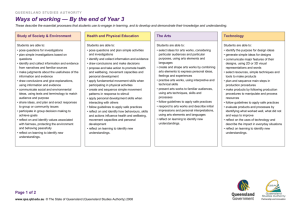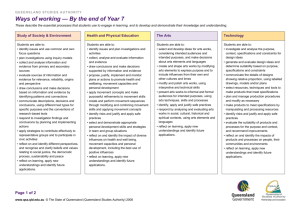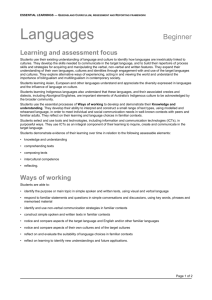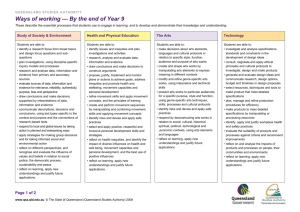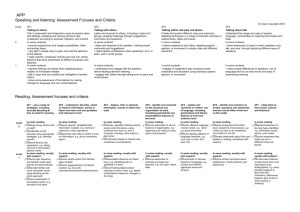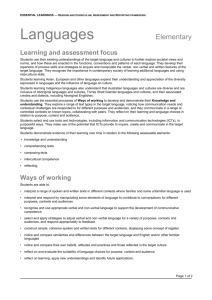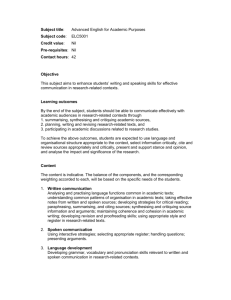DOCX, 60 kB - Queensland Curriculum and Assessment Authority
advertisement
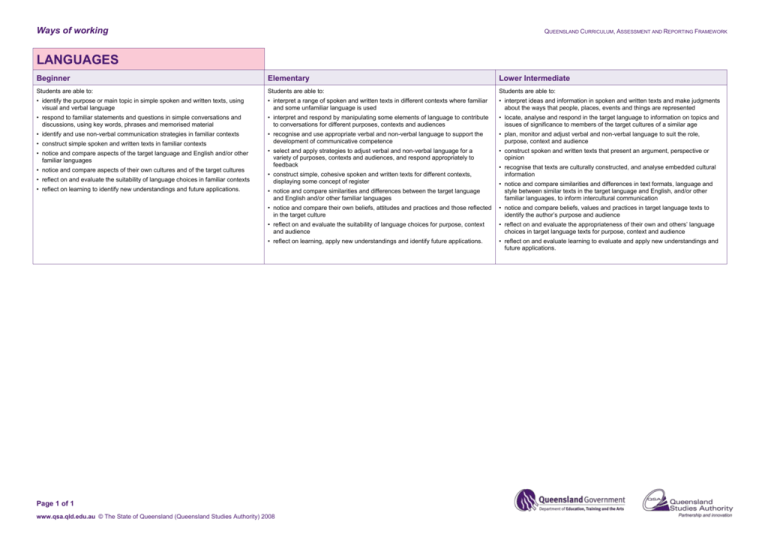
Ways of working QUEENSLAND CURRICULUM, ASSESSMENT AND REPORTING FRAMEWORK LANGUAGES Beginner Elementary Lower Intermediate Students are able to: Students are able to: Students are able to: • identify the purpose or main topic in simple spoken and written texts, using visual and verbal language • interpret a range of spoken and written texts in different contexts where familiar and some unfamiliar language is used • interpret ideas and information in spoken and written texts and make judgments about the ways that people, places, events and things are represented • respond to familiar statements and questions in simple conversations and discussions, using key words, phrases and memorised material • interpret and respond by manipulating some elements of language to contribute to conversations for different purposes, contexts and audiences • locate, analyse and respond in the target language to information on topics and issues of significance to members of the target cultures of a similar age • identify and use non-verbal communication strategies in familiar contexts • recognise and use appropriate verbal and non-verbal language to support the development of communicative competence • plan, monitor and adjust verbal and non-verbal language to suit the role, purpose, context and audience • select and apply strategies to adjust verbal and non-verbal language for a variety of purposes, contexts and audiences, and respond appropriately to feedback • construct spoken and written texts that present an argument, perspective or opinion • construct simple spoken and written texts in familiar contexts • notice and compare aspects of the target language and English and/or other familiar languages • notice and compare aspects of their own cultures and of the target cultures • reflect on and evaluate the suitability of language choices in familiar contexts • reflect on learning to identify new understandings and future applications. • construct simple, cohesive spoken and written texts for different contexts, displaying some concept of register • recognise that texts are culturally constructed, and analyse embedded cultural information • notice and compare similarities and differences between the target language and English and/or other familiar languages • notice and compare similarities and differences in text formats, language and style between similar texts in the target language and English, and/or other familiar languages, to inform intercultural communication • notice and compare their own beliefs, attitudes and practices and those reflected in the target culture • notice and compare beliefs, values and practices in target language texts to identify the author’s purpose and audience • reflect on and evaluate the suitability of language choices for purpose, context and audience • reflect on and evaluate the appropriateness of their own and others’ language choices in target language texts for purpose, context and audience • reflect on learning, apply new understandings and identify future applications. • reflect on and evaluate learning to evaluate and apply new understandings and future applications. Page 1 of 1 www.qsa.qld.edu.au © The State of Queensland (Queensland Studies Authority) 2008
